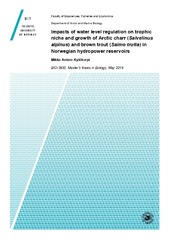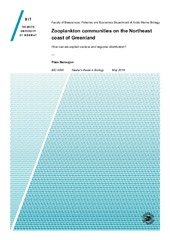Institutt for arktisk og marin biologi: Nye registreringer
Viser treff 1221-1240 av 2050
-
Impacts of water level regulation on trophic niche and growth of Arctic charr (Salvelinus alpinus) and brown trout (Salmo trutta) in Norwegian hydropower reservoirs
(Master thesis; Mastergradsoppgave, 2019-05-15)Hydropower is among the largest renewable energy sources globally. However, it can have drastic environmental and socio-economic impacts on dammed lakes (i.e., reservoirs) and rivers where water levels are regulated due to hydropower operations. Water level regulation in hydropower reservoirs is known to be a large environmental problem, leading to changes in the abiotic conditions, which subsequently ... -
Seasonal abundance and activity of sympagic meiofauna in Van Mijenfjorden, Svalbard
(Master thesis; Mastergradsoppgave, 2019-05-15)The importance of landfast ice as a nursery and breeding ground for Arctic marine invertebrates was studied in Van Mijenfjorden (77°N, 15/16°W), southwestern Svalbard from March to May 2017. The collection of first-year ice cores with stations along a depth gradient allowed the investigation of both temporal and spatial differences in sympagic meiofauna community composition and abundance. Furthermore, ... -
Zooplankton communities on the Northeast coast of Greenland. How can we explain vertical and regional distribution?
(Master thesis; Mastergradsoppgave, 2019-05-16)Most studies on zooplankton investigate the famous, and omnipresent, Calanoid copepods Calanus spp., because they are abundant, and constitute the major trophic link in marine ecosystems. Indeed, Northeast Greenland is located on the crossroad of Arctic and Atlantic waters which, potentially, can lead to a high biodiversity originating from different domains of marine life. However, there are very ... -
Perception and Appreciation of Plant Biodiversity, An assessment of human perception and appreciation of plant biodiversity using photography of artificial plant communities
(Master thesis; Mastergradsoppgave, 2017-07-31)Anthropogenically caused global biodiversity declines and other human drivers point to the possibility of local plant diversity changes. The well-studied effects of local plant diversity on ecosystem processes implicate consequences to human well-being in the form of altered ecosystem services (including cultural services). Public awareness (knowledge and correct perception) about these changes ... -
Greenland Shark (Somniosus microcephalus) stomach contents and stable isotope values reveal an ontogenetic dietary shift
(Journal article; Tidsskriftartikkel; Peer reviewed, 2019-04-04)Current knowledge on the feeding ecology of the Greenland shark (<i>Somniosus microcephalus</i>), a potential top predator in arctic marine ecosystems, is based on small sample sizes as well as narrow size ranges of sharks. Therefore, potential size-related feeding patterns remain poorly documented. Using stomach content data (<i>N</i> = 88) and stable isotope values of white muscle tissue (<i>N</i> ... -
Dead or Alive; or Does It Really Matter? Level of Congruency Between Trophic Modes in Total and Active Fungal Communities in High Arctic Soil
(Journal article; Tidsskriftartikkel; Peer reviewed, 2019-01-08)Describing dynamics of belowground organisms, such as fungi, can be challenging. Results of studies based on environmental DNA (eDNA) may be biased as the template does not discriminate between metabolically active cells and dead biomass. We analyzed ribosomal DNA (rDNA) and ribosomal RNA (rRNA) coextracted from 48 soil samples collected from a manipulated snow depth experiment in two distinct ... -
Efficient sampling for ecosystem service supply assessment at a landscape scale
(Journal article; Tidsskriftartikkel; Peer reviewed, 2018-11-19)Decision makers and stakeholders need high-quality data to manage ecosystem services (ES) efficiently. Landscape-level data on ES that are of sufficient quality to identify spatial tradeoffs, co-occurrence and hotspots of ES are costly to collect, and it is therefore important to increase the efficiency of sampling of primary data. We demonstrate how ES could be assessed more efficiently through ... -
Rodent population cycle as a determinant of gastrointestinal nematode abundance in a low-arctic population of the red fox
(Journal article; Tidsskriftartikkel; Peer reviewed, 2019-03-22)We analyzed an 11-year time series (2005–2015) of parasite abundance for three intestinal nematode species in the red fox (<i>Vulpes vulpes</i>) as a function of the multi-annual rodent population cycle in low-arctic Norway, while correcting for other potential covariates that could influence prevalence and abundance. Rodents are paratenic and facultative intermediate hosts for the two Ascarididae ... -
Contrasting associations between breeding coloration and parasitism of male Arctic charr relate to parasite species and life cycle stage
(Journal article; Tidsskriftartikkel; Peer reviewed, 2019-07-23)Conspicuous carotenoid ornamentation is considered a signal of individual “quality” and one of the most intensely studied traits found to co-vary with parasitism. Since it has been suggested that only “high quality” individuals have enough resources to express excessive sexual ornaments and resist parasites, current theory struggles to explain cases where the brightest individuals carry the most ... -
Arctic charr brain transcriptome strongly affected by summer seasonal growth but only subtly by feed deprivation
(Journal article; Tidsskriftartikkel; Peer reviewed, 2019-06-27)<i>Background</i>: The Arctic charr (<i>Salvelinus alpinus</i>) has a highly seasonal feeding cycle that comprises long periods of voluntary fasting and a short but intense feeding period during summer. Therefore, the charr represents an interesting species for studying appetite-regulating mechanisms in fish. <p> <p><i>Results</i>: In this study, we compared the brain transcriptomes of fed and ... -
Trophic interactions and abiotic factors drive functional and phylogenetic structure of vertebrate herbivore communities across the Arctic tundra biome
(Journal article; Tidsskriftartikkel; Peer reviewed, 2019-04-29)Communities are assembled from species that evolve or colonise a given geographic region, and persist in the face of abiotic conditions and interactions with other species. The evolutionary and colonisation histories of communities are characterised by phylogenetic diversity, while functional diversity is indicative of abiotic and biotic conditions. The relationship between functional and phylogenetic ... -
Stakeholders’ perceptions of protected area management following a nationwide community-based conservation reform
(Journal article; Tidsskriftartikkel; Peer reviewed, 2019-04-24)People’s perceptions can point to reasons for conservation support or lack thereof. In this study, we surveyed the perceptions of conservation among local stakeholders who participated in protected area (PA) management following a reform towards community-based conservation in Norway. We analyzed the link between perceptions of threats to conservation values, prioritized management actions and ... -
Secondary Folds Contribute Significantly to the Total Surface Area in the Olfactory Organ of Chondrichthyes
(Journal article; Tidsskriftartikkel; Peer reviewed, 2019-03-12)The olfactory organ of Chondrichthyes is characterized by a central support with several lamellae covered by a sensory olfactory epithelium. Although secondary folds are present on the lamellae in all the chondrichthyan species analyzed to date, their shape and size have not been described. We here analyze the olfactory organ of 13 elasmobranch and 1 holocephalan species, describe the shape of ... -
New Late Pleistocene species of Acharax from Arctic methane seeps off Svalbard
(Journal article; Tidsskriftartikkel; Peer reviewed, 2019-05-01)We report, for the first time, the solemyid <i>Acharax svalbardensis</i> sp. nov., from deep-sea methane seep sites on the western Svalbard margin, 79°N. This species is rather small and so far the northernmost representative of its genus. It is identified based on the following combination of diagnostic characters: umbo 27–30% valve length from posterior margin; H/L ratio ∼0.35; broadly rounded to ... -
Can multitrophic interactions and ocean warming influence large-scale kelp recovery?
(Journal article; Tidsskriftartikkel; Peer reviewed, 2019-02-14)Ongoing changes along the northeastern Atlantic coastline provide an opportunity to explore the influence of climate change and multitrophic interactions on the recovery of kelp. Here, vast areas of sea urchin‐dominated barren grounds have shifted back to kelp forests, in parallel with changes in sea temperature and predator abundances. We have compiled data from studies covering more than 1,500‐km ... -
Long-term variability in overwintering copepod populations in the Lofoten Basin: The role of the North Atlantic oscillation and trophic effects
(Journal article; Tidsskriftartikkel; Peer reviewed, 2019-04-08)Critical gaps in knowledge hinder our ability to infer spatiotemporal dynamics in pelagic ecosystems. In particular, environmental changes affecting key copepod species while overwintering in deep waters are still not well understood. Here, we analyzed an 11 yr time series (2000–2010) of winter (January/February) samplings in the Lofoten Basin to characterize the spatial distribution of <i>Calanus ... -
Developmental and Environmental Regulation of Cuticular Wax Biosynthesis in Fleshy Fruits
(Journal article; Peer reviewed, 2019-04-19)The aerial parts of land plants are covered by a hydrophobic layer called cuticle that limits non-stomatal water loss and provides protection against external biotic and abiotic stresses. The cuticle is composed of polymer cutin and wax comprising a mixture of very-long-chain fatty acids and their derivatives, while also bioactive secondary metabolites such as triterpenoids are present. Fleshy ... -
Pelagic Ecosystem Characteristics Across the Atlantic Water Boundary Current from Rijpfjorden, Svalbard, to the Arctic Ocean during Summer (2010-2014)
(Journal article; Peer reviewed, 2019-04-09)The northern coast of Svalbard contains high-arctic fjords, such as Rijpfjorden (80°N 22°30′E). This area has experienced higher sea and air temperatures and less sea ice in recent years, and models predict increasing temperatures in this region. Part of the West Spitsbergen Current (WSC), which transports relatively warm Atlantic water along the continental slope west of Svalbard, bypasses these ... -
Ocean predation and mortality of adult Atlantic salmon
(Journal article; Peer reviewed, 2019-05-27)Predation and mortality are often difficult to estimate in the ocean, which hampers the management and conservation of marine fishes. We used data from pop-up satellite archival tags to investigate the ocean predation and mortality of adult Atlantic salmon (Salmo salar) released from 12 rivers flowing into the North Atlantic Ocean. Data from 156 tagged fish revealed 22 definite predation events (14%) ... -
Characterization of the cecum microbiome from wild and captive rock ptarmigans indigenous to Arctic Norway
(Journal article; Tidsskriftartikkel; Peer reviewed, 2019-03-11)Rock ptarmigans (<i>Lagopus muta</i>) are gallinaceous birds inhabiting arctic and sub-arctic environments. Their diet varies by season, including plants or plant parts of high nutritional value, but also toxic plant secondary metabolites (PSMs). Little is known about the microbes driving organic matter decomposition in the cecum of ptarmigans, especially the last steps leading to methanogenesis. ...


 English
English norsk
norsk


















